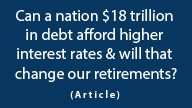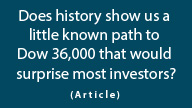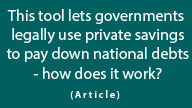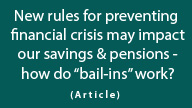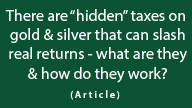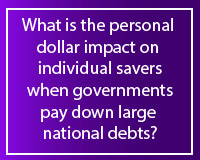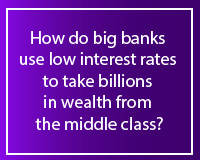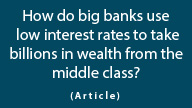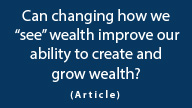Deadly Deflation Myths
by Daniel R. Amerman, CFA
Below is the 2nd half of this article, and it begins where the 1st half which is carried on other websites left off. If you would prefer to read (or link) the article in single page form, the private one page version for subscribers can be found here:
What's In A Name?
When we go down to the firmament – the fundamental level of reality for a nation and the globe – a "dollar" is just a name. A name for a variable, that's all it is. In this case, there is a set of policies and rules for the dollar, which are highly variable, even if the name stays the same.
Consider the simple equation 5 + A = B, with the dollar being "A". By itself, "A" is just a name for a variable, it can mean anything. If "A" stands for 10, then "B" is 15. Change what "A" stands for to 10,000, and then "B" is 10,005.
This may sound like numbers-geek talk, and very few people think about money in those terms. Indeed, a great part of the population finds learning about these issues something to be avoided at almost all costs.
But regardless of whether most people understand this or not, it doesn't change the reality that the dollar is just the fixed name for an underlying variable which is anything but fixed. This "technicality" profoundly influences our economy. It can change income, employment and daily standards of living for the nation, and is currently the dominant factor in determining investment performance – at least in the early 21st century.
To better see this, let's track some of the recent changes in the variable behind the name, and how they have transformed the day to day lives of most of the nation and the world. As a starting point (though not "the" starting point), the United States faced major issues with a recession in the early 2000s due to the popping of the tech bubble and the resulting destruction of paper wealth.
The Federal Reserve made the decision not to wait out the recession, but rather to use its powers over the rules and policies that governed the symbol. It set out to counter the negative effects caused by destruction of paper wealth in an asset bubble ("wealth" that incidentally was itself never real) by making the dollar low cost and plentiful. In a move to stimulate the economy, it facilitated the creation of cheap and easy money by the banking system at low interest rates.
The lives of almost every person reading this – in the United States as well as around the world – changed with that decision, whether they were aware of it or not.
That is, while the name "dollar" stayed the same – its underlying nature changed. Moreover, instituting policies that enabled the creation of cheap and easy dollars by the trillions (albeit not directly by the Federal Reserve itself – yet) is what fueled the creation of the real estate asset bubble. For without a plentiful supply of money for all kinds of mortgages at remarkably low interest rates, real estate prices could never have climbed nearly as high as they did, because making mortgage payments would have been unaffordable.
If you made a great deal of money in real estate in the early to mid-2000s, whether through investing or just watching your home equity climb – it happened because the variable behind the name changed. And with that change in what the dollar really was, the economy changed, and so did the net worth of every real estate owner in the nation.
And when this artificially-induced bubble popped, if you or someone you know lost a great deal of money whether by foreclosure, or getting trapped in an underwater home – again, it was that geeky technicality of the rules behind the name changing that had created the bubble of prices inflating, and whose destruction had such a tragic effect on the lives of so many millions of Americans.
A Major Rewriting Of The Rules
In October of 2008, the collapse of the world's financial system was imminent as a result of the implosion of the US subprime mortgage derivatives market, which was driven by the popping of the cheap money-based real estate bubble.
There was a liquidity crisis raging, and a global bank run was in progress. Institutional investors were demanding back the money that they had lent to the major banks, but the banks didn't have the money, and if they were to sell their toxic assets at fire-sale prices to get the money, they would all become insolvent – leading to potential global financial devastation and global depression.
On a national basis, if the dollar were "a dollar" as the general population or many deflationist theorists see it, then it would have been game over, with no way out, because the money simply didn't exist to solve the crisis.
However, the financial order didn't collapse. That is because the person in charge of the rules governing the US dollar happened to thoroughly understand the two deflation myths we've explored thus far, and at will, he used the power of the Central Bank to transform the very nature of the nation's currency.
Benjamin Bernanke was fascinated by the US Great Depression of the 1930s, he'd been a lifelong student of its lessons, and he understood forwards, backwards and sideways that by changing the rules and the nature of money, what had seemed to be unstoppable deflation could be stopped in its tracks, in a matter of weeks. After many years of study, he had become convinced that the Depression had been longer and more severe than it needed to be, the problem being that the government was too timid, and that it should have aggressively changed the rules governing the dollar much sooner than it did.
Faced with a severe global crisis (which had many culpable "fathers", but the fuel for which was created by the Fed's folly in quite deliberately trying to overrule the business cycle with its interventions), Ben Bernanke chose not to walk away from policy changes gone bad – but rather to "double down" with an exponentially greater change in the nature of the dollar. Thus the response of the Federal Reserve to an existential global crisis was to swiftly and aggressively rewrite the rules, by fundamentally transforming the currency – all while keeping the name constant.
Quantitative Easing One created over $800 billion in new money out of the nothingness in a matter of weeks, giving the banks what they needed to meet the liquidity crisis and stay technically solvent.
Understanding that at its core, a symbolic currency is no more than rules and policies, Bernanke reacted to a seemingly impossible crisis by just doing a major rewrite of part of the equation – the rules and policies governing the dollar – and effectively deciding that "Y = $800 billion" instead of its former value of zero. (For those interested, there is a much more detailed description of excess asset reserves, sterilization and how this worked on my website's home page).
This new money was greater than total US physical currency in circulation after 200 years, and in excess of total annual US income tax revenue from just a few years before. The old rules behind the pre-2008 dollar disappeared, being replaced by the new rules, and the $800 billion in freshly created new dollars stopped the bank run in its tracks. None of which was particularly noticed by the population at large, because the variable's name, "the dollar", hadn't changed.
Symbols Creating Reality
However, what did change was the financial world as we knew it.
This is good place to think about two worlds that could exist today – but don't.
1) Think about how different your life and the lives of your loved ones might be if there had been an overt and complete financial collapse in 2008.
2) Think about how different your life and the lives of your loved ones might be if the Federal Reserve hadn't enabled the growth of the real estate bubble and subprime mortgage derivatives market in the first place, if there hadn't been any danger of collapse or crisis in 2008 and 2009, and if the "Great Recession" had never followed.
Either way, let me suggest that employment, income, net worth, retirement, and even food on the table might be working quite differently for many people.
And either way, investment performance would also have been radically different across all major categories including stocks, bonds, precious metals and real estate.
Indeed, when it comes to investment performance across all categories over the last 15 years, there is a very strong case to be made that the two dominant factors have been:
1) Changes in the nature of money in many nations; and
2) The interests of governments and powerful special interest groups, which are what determined which of the possible changes in the nature of money have in fact occurred.
In other words, there is much more variability to what money is and how wealth is redistributed than many realize. The process is far from neutral, and what guides the outcome is monetary gain, power and self-interests.
The tinkering has been nearly continuous since then.
Quantitative Easing One began with bank rescue and then morphed into real estate rescue, transforming real estate investment for the nation.
Quantitative Easing Two attacked the value of the US dollar (thereby changing global trade and stock market performance), and took control of US interest rates and therefore the bond markets – and therefore US solvency when it came to interest payments on the debt. The measures deployed reduced interest earnings by trillions of dollars, negatively impacting tens of millions of savers and investors, as well as pension funds.
Quantitative Easing Three has, among other things, created high bond prices, rising stock market levels, and rising real estate prices. It has contributed to a reduction in precious metals prices, and has enabled a profound redistribution of wealth within society.
Tapers are checking the increases in stocks, and have pushed emerging markets into a tailspin around the world.
Investment performance in any major category around the United States (and much of the world) over the last 15 years cannot be explained without including the profound effects of governments changing the nature of money in a way that serves their own self interests.
Nor can current pricing levels in any major category be explained – without factoring in those effects.
Which raises an essential question: if we can't explain investment markets performance in the past or present without taking into account self-serving governmental interventions that change the rules and nature of money, then how likely are we to make prudent investment decisions for the future, if we ignore those factors?
If the price and yield history of stocks, bonds, precious metals and real estate have all been profoundly influenced by these factors, then how can one make good investment decisions without at least incorporating them as one part of the decision-making process?
The Problem With Deflationary Theory
When it comes to money, my issue with much of deflationary theory is that it is based on myths rather than the two powerful historical realities covered herein. Just as it ignores recent economic history.
Yes, the textbook case for deflation in terms of the supply and value of money occurred in 2008, as it did in 1929. And in both cases the chosen remedy was the same: deflation threatened the currency, and so the rules governing the currency were changed.
When you have a symbolic currency with no outside limitations, the equation can always be rewritten to infinity, as has been shown in a number of nations. And if a nation goes to that extreme, and rewrites the rules and policies to force the creation of a near infinite amount of dollars, this can very quickly translate to hyperinflation and a near zero value for the currency.
Taken to this extreme, this is an absolute power, and there is no struggle. Which means that with a symbolic currency like the US dollar – which only exists by government fiat – inflation can always trump deflation at any time when it comes to the value of money.
Now, the "trick" for the Central Bank – and the corresponding risk for the nation – is the precision involved in not going to the extreme, but rather destroying just enough of the value of the currency to offset deflation while still maintaining control of that process. Too radical a rewriting of the equation, then control to the downside might be lost, and for a combination of external and internal factors, the currency may plunge in value far beyond what was sought (maintaining the value of a symbol is much trickier than destroying that value.)
(Another consideration is that the more powerful the case for monetary deflation with a symbolic currency, and the greater the risks for the nation, then the stronger and riskier the strategies that must be deployed by a Central Bank to fight that deflation, and thus the greater the chances of events spinning out of control, and therefore the greater the damage to the value of the currency. So when someone makes what appears on the surface to be an overwhelming case for deflation - they may actually be making an even stronger case for inflation. Interesting and mind-bending stuff, but I digress...)
To be clear, however, this is not to say that deflation isn't a major danger or that governments can always overcome it. For there is a different and more powerful kind of deflation, the dangers of which are much more solidly-based in both theory and history, and against which governments and markets can be rendered near helpless for decades.
This much more powerful and thus much more dangerous type of deflation consists of changes in the inflation-adjusted value of actual assets, such as securities, property and precious metals. There is a long history of such asset deflation devastating markets in nations for potentially decades at a time, as they try to recover from financial excesses. And this is why as I stated early on, I am an asset deflationist, for I fear that there is a strong chance that asset deflation in purchasing power terms may become an unstoppable force in the coming decade.
In summary, key aspects of current deflationary theory can be characterized as the combination of 1) an absurdity; 2) a misunderstanding; and 3) an oversimplification; all working together to create 4) a serious danger for investors.
The absurdity is the idea that a symbolic currency has some sort of inherent value and power, which a central bank or nation is powerless to fight, creating a situation where the symbol continues to soar in value in a manner that creates or reinforces economic depression.
The misunderstanding, as explored herein, is looking to the history of gold and other asset backed currencies - which are prone to powerful deflations that nations can indeed find impossible to overcome - and assuming that also applies to symbolic currencies, just because the name remains the same.
The oversimplification is mixing the value of money in with the value of assets and thereby saying it must be either deflation or inflation, with those being the only two choices.
The major danger is that because many believe that deflation is highly likely for assets when it comes to value, then because of the misunderstanding and the oversimplification, they believe that they are somehow protected when it comes to the value of their money - and tragically, they could not be more mistaken.
We will explore two further myths about deflation in the second part of this article, as we consider the differences between the value of assets, and the value of money.
To be continued...
 What you have just read is an "eye-opener" about one aspect of the often hidden redistributions of wealth that go on all around us, every day.
What you have just read is an "eye-opener" about one aspect of the often hidden redistributions of wealth that go on all around us, every day.
 A personal retirement "eye-opener" linked here shows how the government's actions to reduce interest payments on the national debt can reduce retirement investment wealth accumulation by 95% over thirty years, and how the government is reducing standards of living for those already retired by almost 50%.
A personal retirement "eye-opener" linked here shows how the government's actions to reduce interest payments on the national debt can reduce retirement investment wealth accumulation by 95% over thirty years, and how the government is reducing standards of living for those already retired by almost 50%.
 An "eye-opener" tutorial of a quite different kind is linked here, and it shows how governments use inflation and the tax code to take wealth from unknowing precious metals investors, so that the higher inflation goes, and the higher precious metals prices climb - the more of the investor's net worth ends up with the government.
An "eye-opener" tutorial of a quite different kind is linked here, and it shows how governments use inflation and the tax code to take wealth from unknowing precious metals investors, so that the higher inflation goes, and the higher precious metals prices climb - the more of the investor's net worth ends up with the government.
 Another "eye-opener" tutorial is linked here, and it shows how governments can use the 1-2 combination of their control over both interest rates and inflation to take wealth from unsuspecting private savers in order to pay down massive public debts.
Another "eye-opener" tutorial is linked here, and it shows how governments can use the 1-2 combination of their control over both interest rates and inflation to take wealth from unsuspecting private savers in order to pay down massive public debts.







If you find these "eye-openers" to be interesting and useful, there is an entire free book of them available here, including many that are only in the book. The advantage to the book is that the tutorials can build on each other, so that in combination we can find ways of defending ourselves, and even learn how to position ourselves to benefit from the hidden redistributions of wealth.


